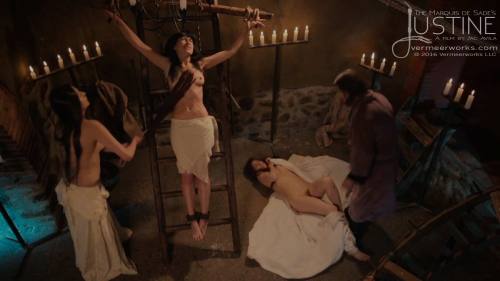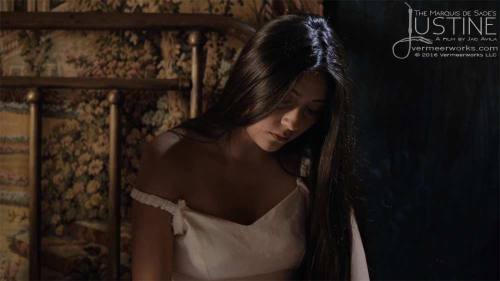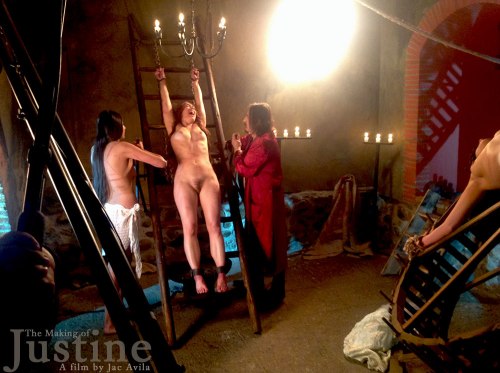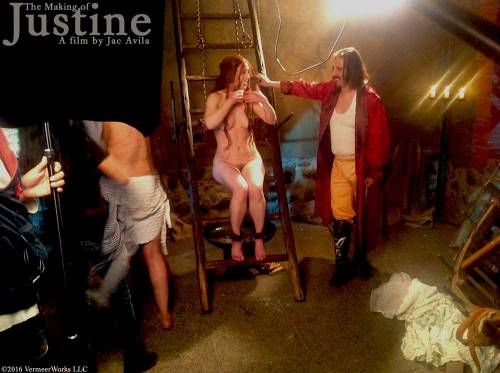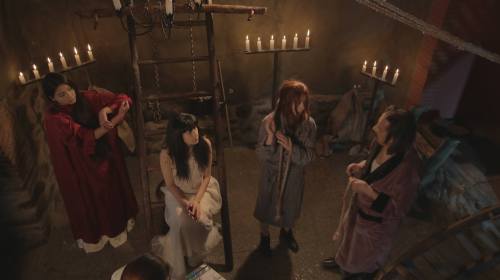by Rich Moreland, March 2017
In this post, Mila Joya and Beatriz Rivera who play Rosalie and Omphale respectively in Pachamama Films’ Justine, talk about how they interpreted their characters.
Director Jac Avila, who plays the evil Rodin, also relates how he viewed his role as the dominant figure in the film.
* * *
Actresses in Jac Avila films endure the sadistic urgings of their tormenters, especially in movies like Maleficarum and the subject of this article, Justine. The film features a trio of alluring women: Amy Hesketh, Mila Joya and Beatriz Rivera.
“When they do get into their characters,” Jac says, “they go into them with intensity and completely. They become those characters for the time of the shooting.”
He remarks that the most intense scenes can take a physical and mental toll on the performers.
“The whippings hurt, the crucifixions are very, very uncomfortable and even painful, there’s a lot of real suffering going on. I do not think that any of them enjoy that, they put up with it for the art,” he concedes.
An Erotic Parody
Jac summarizes his basic premise in creating Pachamama Films’ adaptation of Justine.
“I wanted to make an erotic parody of a parody of the times of De Sade which, ultimately, are not very different from ours.”
With any adaptation, character portrayal is always in flux and may not always fit the original story, Jac points out, so “the characters will make a statement of some kind as you develop them.”
That’s important because Jac believes his version of Justine is “not so much an S/M adventure,” but “more like a misadventure with sadistic consequences.”
“There’s no horror,” he explains, “except for the natural horror” that plagues humanity.
“Justine is an erotic film, of course, especially if you are into beautiful ladies suffering torture and martyrdom,” he says. “All those beautiful bodies with very little or nothing covering them, is erotic in and of itself.”
As for the film’s theological comments, they reflect Jac’s Catholic upbringing.
“Justine’s quotes about God and women come straight from the nuns that were my teachers in grammar school. They were Sadean in the biblical sense,” he comments.
All Three Women are Weak
Let’s take a look at how Mila Joya, who plays Rosalie, and Beatriz Rivera, who plays Omphale, interpreted their roles. How did they see their characters moving the story forward?
To set us up for their responses, Jac first explains his part in the production.
“I play Rodin, an insidious character who has a lot of control over people’s lives and behaviour, particularly his daughter and his servant Omphale.”
The evil doctor’s “deranged whims” drive the film, Jac says. He is “god-like, as when god carries those attributes of power and evil” and “the “antithesis of Justine,” who narrates the tale.
Mila offers her view of her part in the film.
“Rosalie is a very interesting character because she’s the daughter of Rodin, there lies the big conflict, because of how ‘heavy’ [domineering] her father is. How she moves the story is complicated because there are moments where she loves Justine, she wants to help her but she can’t do anything. She knows she’s going to die, so she is resigned to her fate.
Mila summarizes Rosalie this way,
“I see her as very weak, the typical example of women that are oppressed mostly because of the time they live in.”
 In fact, Mila’s take on Justine, Rosalie, and Omphale is straightforward.
In fact, Mila’s take on Justine, Rosalie, and Omphale is straightforward.
“All three women are weak,” she insists.
Bea interprets her character Omphale as “totally submissive because she was under Rodin’s tutelage, power, for as far [back] as she can remember. She allies with him when he commands her to torture the others. She’s also a coward because she accepts all of his commands, never challenging him.”
“The fact that she’s Rodin’s accomplice already moves the story forward. She agrees to massacre the other girls but she doesn’t question him and doesn’t ask herself why she should experience the same,” Bea comments. “Why not have a life like everybody else, a normal life?”
On the other hand, Bea also sees Omphale as “evil and submissive. Submissive to Rodin and evil because she has no problems in punishing the others, she shows no regret, no pity.”
Though Rosalie’s helplessness and Omphale’s lack of insight into her own existence raise questions, De Sade avoids exploring the characters in-depth leaving the interpretation of how to play these women up to the actresses.
The results are thought provoking in a highly recommended film.
* * *
In our next post, we will examine how the players faced the challenges of Justine, including the torture scenes, and how the cast interacted with each other . . .
During the shoot . . .
While taking a break . . .
And in conference to make sure everyone is on the same page . . .
* * *
Justine is available for purchase from Vermeerworks here.



